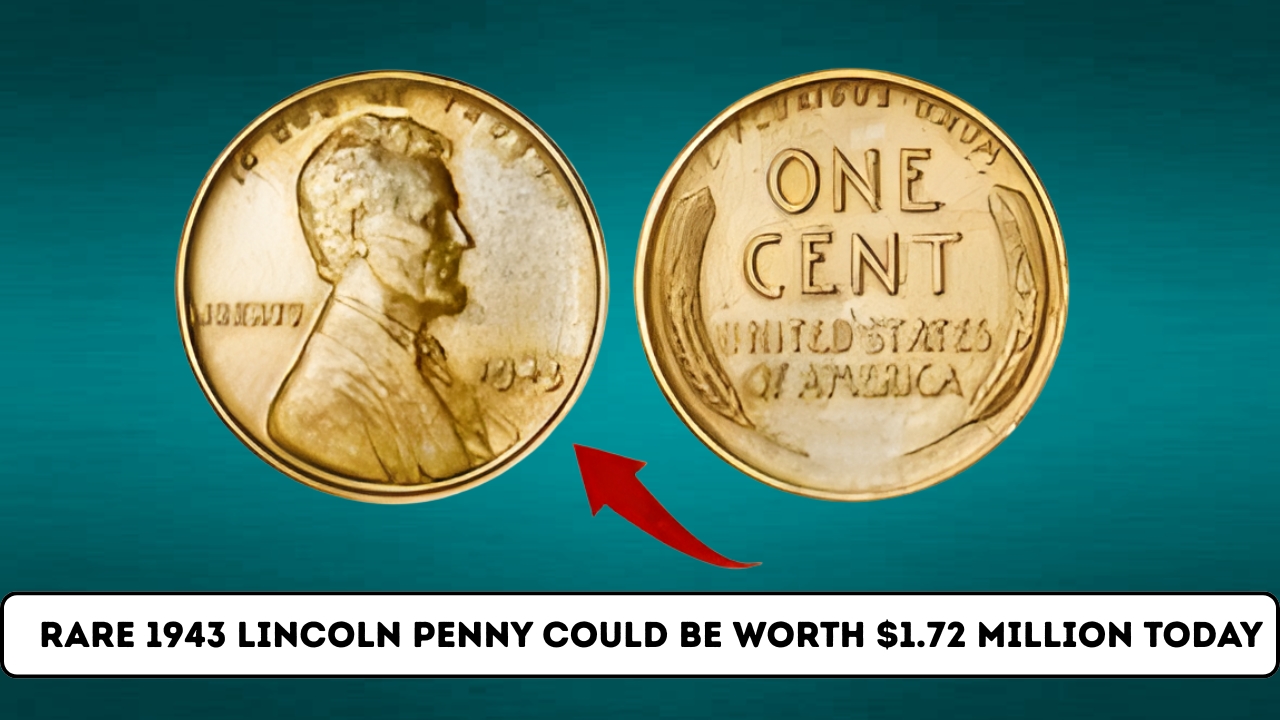Sometimes, the smallest things can hold the biggest surprises—and the 1943 Lincoln penny is one of those amazing little treasures. Imagine finding a simple old copper coin tucked away in your drawer or mixed in with loose change, only to discover it could be worth over $1.72 million today. Sounds unbelievable, right? But it’s absolutely true—and the story behind this rare penny is just as fascinating as its value.
Let’s dive in and uncover how a simple mistake at the U.S. Mint turned a common coin into a millionaire’s collectible.
The Unlikely Origin of the 1943 Copper Penny
In 1943, World War II was in full swing, and copper was in high demand for military equipment like bullets and wire. To conserve copper, the U.S. Mint decided to produce pennies using steel coated with zinc instead. These “steel cents” looked shiny and silvery, quite unlike the usual reddish-brown copper coins people were used to.
However, due to a minting error, a small batch of pennies that year was accidentally struck on leftover copper planchets from 1942. In other words, a few copper blanks slipped through the cracks and ended up being used to make 1943 pennies.
This simple oversight created one of the most sought-after coins in American history—the legendary 1943 copper Lincoln penny.
How Rare Is It Really?
Now, here’s where it gets interesting. Experts believe that only about 20 to 40 genuine 1943 copper pennies exist across all three U.S. mints—Philadelphia, Denver, and San Francisco. That’s right—out of the more than one billion steel pennies made that year, just a few dozen copper ones were mistakenly produced.
Because of this rarity, collectors go absolutely wild for them. Even a circulated example—one that’s been used and isn’t in perfect condition—can sell for hundreds of thousands of dollars. Meanwhile, high-grade, uncirculated specimens can easily fetch over $1 million, depending on condition, mint mark, and provenance.
Record-Breaking Sales
Over the years, several of these coins have made headlines. In one famous case, a 1943 copper penny was sold at auction for $1.75 million, setting a new record for small change. The coin was originally discovered by a teenage collector back in the 1940s who kept it safe for decades before selling it.
Another example, from the Denver Mint (marked with a tiny “D”), fetched nearly $1.7 million in a private sale. And to be fair, given the rarity, it’s not hard to see why collectors are willing to pay such astronomical sums.
Below is a quick snapshot of the most notable 1943 copper penny sales:
| Year Sold | Mint Mark | Condition (Grade) | Price Realized | Auction House |
|---|---|---|---|---|
| 2010 | Philadelphia (no mark) | MS-63 Red | $1.7 million | Heritage Auctions |
| 2019 | Denver (D) | AU-55 | $1.68 million | Private Sale |
| 2021 | San Francisco (S) | MS-62 Brown | $1.2 million | Stack’s Bowers |
| 2023 | Philadelphia | VF-35 | $840,000 | Heritage Auctions |
| 2025 (est.) | Any mint | Any grade | Up to $1.72 million | Ongoing valuations |
How to Know If You Have One
Alright, here’s the part that everyone secretly wonders—could I have one of these in my coin jar?
Honestly, the odds are slim, but not impossible. Here’s how to check:
- Look at the date: It must read 1943.
- Check the color: Genuine 1943 copper pennies have a reddish-brown tone, unlike the silvery steel ones.
- Use a magnet: Steel pennies are magnetic, but copper isn’t. So if your 1943 penny sticks to a magnet, it’s steel, not copper.
- Inspect the mint mark: Look for a small “D” (Denver) or “S” (San Francisco) below the date—or none at all (Philadelphia).
- Get it authenticated: If you suspect it’s genuine, send it to a certified grading service like PCGS or NGC.
Many fakes exist—especially copper-coated steel pennies—so authentication is crucial.
Why It’s More Than Just Money
Beyond the dollar value, this penny tells a story—a story of wartime America, resourcefulness, and a tiny mistake that turned into a fortune. Collectors often see these coins not just as investments but as pieces of living history. They represent a moment in time when the entire nation was united in a massive effort, and even small things—like copper—were too valuable to waste.
To be fair, not everyone will find a millionaire penny. But the thrill of the hunt, the mystery of old coins, and the historical depth behind each one make the search totally worthwhile.
So yes, the 1943 Lincoln copper penny could absolutely be worth up to $1.72 million today—and that’s no exaggeration. It’s a powerful reminder that sometimes, extraordinary value can come from the most ordinary-looking things. If you ever come across a 1943 penny that doesn’t look silvery, don’t just toss it aside. Give it a closer look—it might just change your life.
After all, who wouldn’t love to find a million-dollar mistake lying around in their pocket change?
FAQs
1. Why were 1943 pennies made of steel?
Because copper was needed for World War II materials, the U.S. Mint used zinc-coated steel instead.
2. How many 1943 copper pennies are known to exist?
Experts estimate between 20 and 40 genuine examples across all U.S. mints.
3. How can I tell if my 1943 penny is real copper?
A simple magnet test helps—copper isn’t magnetic, but steel is.
4. Can a 1943 copper penny really be worth $1.72 million?
Yes, high-grade examples have sold for over $1.7 million in auctions.
5. Where should I get my coin authenticated?
Send it to a professional grading service like PCGS or NGC for verification.
